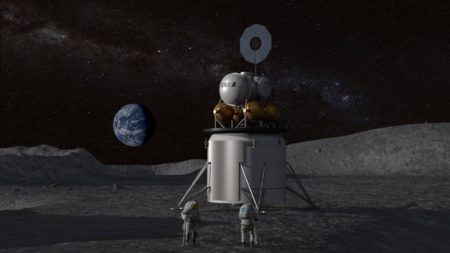May 18, 2019 – The NASA of 1969 contracted a few companies to help it get a human crew to the Moon and back. But in 2019 the floodgates for commercial partners have been opened wide as the Agency tries to meet a politically-set target date of 2024.
First on the agenda is to develop the Lunar Gateway, a mini version of the International Space Station (ISS) to be located in close proximity to the Moon from which human crews can descend and return to and from the lunar surface.
So how to go about doing that?
In 1969 Grumman Aircraft, a Long Island, New York-based company was the builder of the Lunar Excursion Module (LEM), a one-time use vehicle that combined a descent and ascent stage and pressurized cabin with life support systems for the astronauts. The cost of each LEM worked out to around $150 million USD a pop and 9 flew on missions equaling a total cost of $1.35 billion. The LEM contract was awarded in 1963 and it was six years before the first made it to space.
So two announcements about NASA’s future Moon project, now called Artemis, caught my eye in the last couple of weeks.
First, it was the Trump administration’s request to Congress to top up the NASA budget by an additional $1.6 billion for the current year. I wondered just how far that money would go to meet the new Moon mission. Remember the entire LEM build was costed in 1960s US dollars, not based on the current dollar’s purchasing power. I would imagine $1.6 billion isn’t going to pay for much today.
Then the second announcement involving a $45.5 million contract from NASA to 11 commercial partners begin preliminary work on lunar lander designs and prototypes seemed to me to be a pittance of what was needed for Artemis to begin. The 11 companies include the known suspects and a few outsiders. They are in alphabetical order:
- Aerojet Rocketdyne
- Blue Origin
- Boeing
- Dynetics
- Lockheed Martin
- Masten Space Systems
- Northrop Grumman Innovation Systems
- OrbitBeyond
- Sierra Nevada Corporation
- SpaceX
- SSL
The $45.5 million isn’t evenly divided among the 11 with some companies being asked to create prototypes for sub-systems, while others compete on designing main elements of a future lunar lander.
For example, Blue Origin, Boeing, Dynetics, Northrop Grumman, Lockheed Martin, Sierra Nevada, and SpaceX are all being asked to do descent stage prototypes and may the best one win. It is hard to tell if this is or is not being structured like one of NASA’s many prize contests which award money to one or more project teams when they develop innovative solutions the Agency deems necessary for the future of the space program. And even though $45.8 million is being offered the companies receiving the money have been asked to foot 20% of the total project costs. I don’t know if any other NASA contracts ask commercial providers to eat some of their costs specifying just how much.
What’s in a Name?
And another thing, when Jim Bridenstine, NASA’s administrator, announced the new mission’s name, Artemis, the Greek goddess associated with the hunt and the Moon, he may have overlooked a legacy NASA mission also named ARTEMIS first launched as Themis-Artemis to study the Earth’s magnetosphere and the Moon’s interactions with the Sun. That ARTEMIS is an acronym for the Acceleration, Reconnection, Turbulence and Electrodynamics of the Moon’s Interaction with the Sun mission.
It is ongoing to this day studying how solar and cosmic radiation impacts the lunar surface in the absence of a protective magnetic field such as the one we have here on Earth. For humans landing, exploring, and living on the Moon, that ARTEMIS should help to determine what ways are needed to protect those who plan to arrive in 2024 on the other Artemis, the lunar lander.
I’ll forgive Jim Bridenstine for not having brushed up on NASA history. But didn’t anyone at the Agency not tell him that the name Artemis had already been taken?















